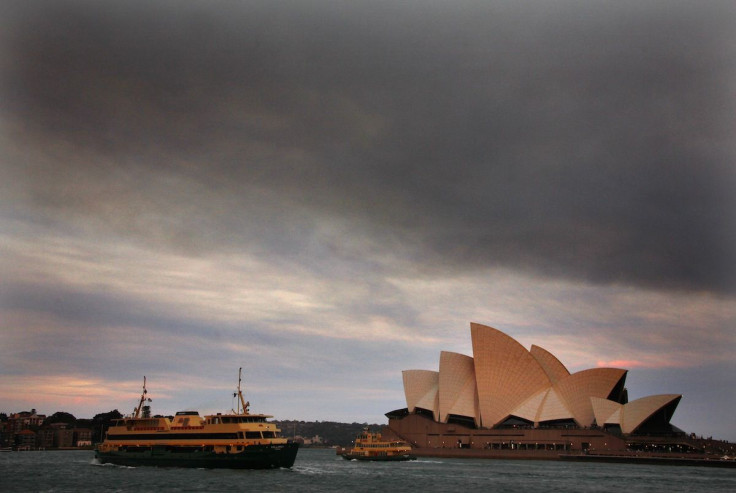Bushfires In Australia Disrupt Flights, Close Sydney-Area National Parks And Put Blue Mountains On Edge

Dozens of bushfires have encircled the Sydney metropolitan area for five days now, destroying more than 200 homes, damaging at least 100 others and leaving several communities on high alert. The worst, however, may be yet to come.
“Weather conditions over the next few days will deteriorate significantly, and there is potential for a significant and widespread danger to life and property across the state,” New South Wales (NSW) Premier Barry O’Farrell said Sunday as he issued a state of emergency, citing warnings from the Rural Fire Service (RFS) commissioner. “This is not an action taken lightly by either the Commissioner, the Minister or myself, but it’s important the Rural Fire Service and other emergency services have the powers and the resources they need to combat this threat.”
O’Farrell added that he was “planning for the worst but hoping for the best.” The state of emergency triggered a range of measures that will allow emergency personnel to direct the public to evacuate an area or not enter an area, order power and gas supplies to be shut off, shore up or pull down buildings and enter premises to facilitate the exercise of these powers.
“I again urge people in bushfire-prone areas to prepare their homes and have a bushfire survival plan,” Emergency Services Minister Michael Gallacher stated. Gallacher asked the public to stay tuned to the media, official social networking sites and the RFS website to keep up to date with the latest information.
Meteorologists believe a dry winter and hotter than average spring combined to form perfect conditions for the 60 odd bushfires currently raging across Eastern Australia (14 of which were considered “out of control” Monday). NSW officials say they are the most dangerous conditions in more than 40 years.
National Parks, Travel And Tourism
The NSW National Parks and Wildlife Service said Monday afternoon that active bushfires raged across 11 national parks and state conservation areas, particularly in the Blue Mountains, a popular destination about an hour from downtown Sydney. The emergency situation, meanwhile, forced the closure of all parks in the Greater Sydney Metropolitan Area.
“These closures are necessary to ensure public safety whilst the NSW National Parks and Wildlife Service deploys all available firefighters to assist the Rural Fire Service and NSW Fire and Rescue in combating the fire emergency situation across the Blue Mountains and Southern Highlands,” the park service said in a statement Monday.
Despite the closures, major vehicle-accessible lookouts in the Blue Mountains remained open, like those on the southern side of Wentworth Falls, Leura and Katoomba, home to the iconic “Three Sisters” rock formation. Visitor information centers at Echo Point, Katoomba and Glenbrook were also open and on standby for an escalation of fire threat, as was the popular Scenic World attraction.
In the Lithgow area, the heritage-listed Zig Zag Railway lost its assets to a bushfire.
Members of the regional organization Blue Mountains Lithgow & Oberon Tourism, or Bmlot, gathered for an emergency meeting Sunday at the Blue Mountains Fire Control Center to create a list of recommendations for tourism operators in the area. It asked hoteliers to provide guests with a deferred visit option, and it urged all tour companies to end all bushwalking activities for the indefinite future.
“The risks we face over the coming days should not be underestimated,” Bmlot Chairman Randall Walker warned. “It is our paramount mission to ensure that no visitors to our region are injured due to bushfires.”
Walker said that members of the tourism industry, one of the region’s main employers, had been among those who lost their homes to the fire. “We express our deep thanks to all volunteers fighting the bushfires, protecting lives and property, and providing support services, including many tourism industry people,” he said.
The bushfires have not directly affected Australia’s biggest city, but smoke in the air has occasionally plunged Sydney into midday darkness and caused problems for travelers getting into and out of the airport. Airservices Australia, which manages the majority of the country’s air space, said it had limited landings in Sydney from 50 an hour to 34 on Monday as bushfire smoke reduced the visibility to about 1,200 meters (3,940 feet). Meanwhile, a United Airlines flight that blew out its tires on takeoff from Sydney Sunday night caused a ripple effect of delays and cancellations across the country that dragged into Monday morning.
A Bad Situation About To Get Worse
Temperatures in the greater Sydney area hit 33 degrees Celsius (91 Fahrenheit) Monday afternoon, which is unseasonably warm for mid-Spring. Higher temperatures and strong winds across New South Wales are expected to continue through at least Wednesday and make an already bad situation worse in Australia’s most populous state.
Nowhere is the threat greater at the moment than in the already hard-hit Blue Mountains, where RFS said it’s possible that the two major infernos burning in the area could merge together with another blaze in nearby Lithgow. “We can understand the magnitude of that as it would then creep into the bottom end of Sydney,” an RFS spokesperson said. “It’s certainly something that we’re very concerned about.”
The foothills of the Blue Mountains lie just across the Nepean River from Sydney’s western suburbs, and embers already jumped its banks last week to start a fire near Penrith.
RFS Commissioner Shane Fitzsimmons told reporters Monday that there would be several difficult days ahead. “We’ve got what would be unparalleled (conditions) in terms of risk and exposure for the Blue Mountains and Hawkesbury communities throughout this week,” he said. “If you are to draw a parallel, and it’s always dangerous to draw a parallel, at best you’d be going back to time periods in the late 60s.
“The reality is, however, these conditions that we’re looking at are a whole new ball-game and in a league of their own.”
© Copyright IBTimes 2024. All rights reserved.












